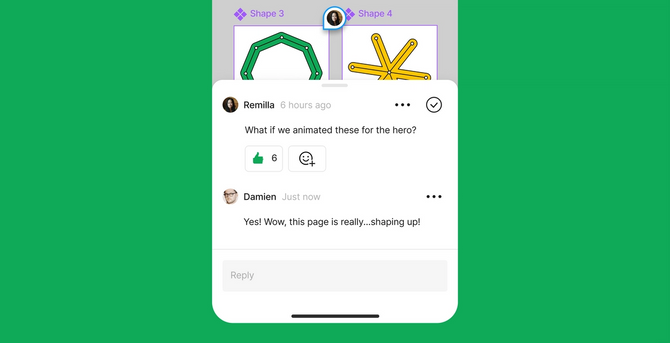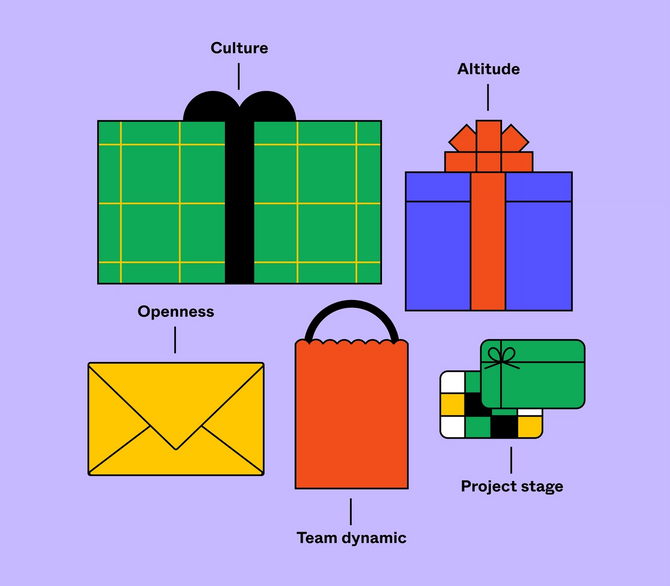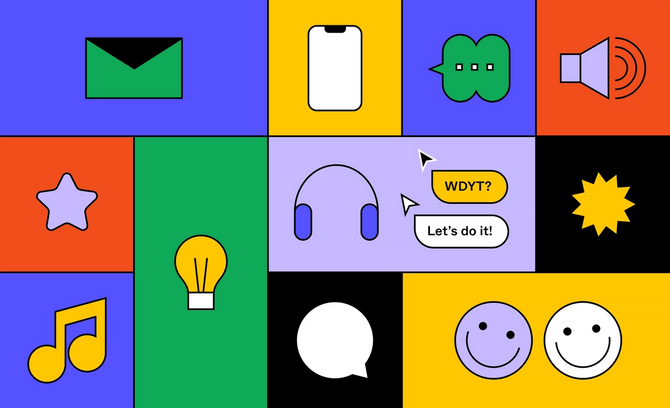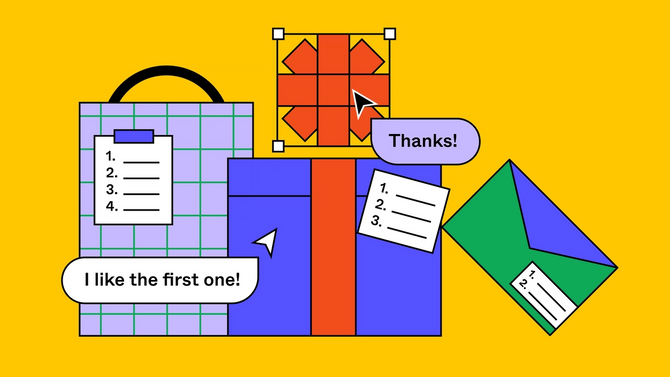

Figma's feedback gift guide
source link: https://www.figma.com/blog/figmas-gift-guide-how-to-give-great-feedback/?ref=sidebar
Go to the source link to view the article. You can view the picture content, updated content and better typesetting reading experience. If the link is broken, please click the button below to view the snapshot at that time.

Figma's feedback gift guide

With all the ways we communicate (Email! Slack! Zoom!) in our hybrid work world, it can feel hard to turn conversations and ideas into action, and feedback is a huge part of that. We’ve pulled together this handy guide to help you get better and giving and receiving feedback.
They say feedback is a gift. But just like fruitcake makes for a head-scratching Valentine’s Day present, feedback needs to be tailored to the occasion and the relationship if it’s to be met with open arms. How collaborative is the team culture? How urgent is feedback for the project? What time zone is your teammate in? Without a thoughtful approach to giving and receiving—even with the best intentions—your feedback can end up chucked in the trash, straining working relationships, and spiraling projects into an endless back-and-forth. Fortunately, we’ve assembled Figma’s feedback gift guide to help you give feedback that makes your team’s best-of list.
The right time
Knowing when to give great feedback is as important as what to give
For every gift there is a season, and good feedback is as much about when as what. Companies, design teams, projects, and (most importantly!) people all have unique constraints and timelines. It’s important to deliver feedback when it can be most constructive and well-received.

Match feedback to fidelity
It can be hard not to declare a direction a definite "no" or jump to color choices for early concepts—our brains love to fill in the gaps! But design is a process for a reason. Thinking about the intent behind each step in a project will help you make better communication decisions along the way.
- Brainstorming sessions are a time for thinking expansively about different directions. Feedback that tightens the net too early will limit the possibilities.
- Early concepts require a still-open mind. Feedback that uses research or data to narrow the field of options can help a project move confidently into wireframes.
- Feedback during product reviews ensures that the work is aligned to product and business goals.
- Design critiques help designers get nitty-gritty UX and visual ideas from their team, and promote consistency across products.
- Prototypes beg for feedback around usability and animation.
- High-fidelity designs require rigorous examination of details that can augment the designer’s perspective.
- When delivering final designs, designers need to know if all the bases have been covered, or if there’s a flow or use case that needs more attention.
When soliciting input at any of these stages, you can provide focus and set expectations by outlining the kind of feedback that would be most helpful to receive.
Try these six critique methods from the Figma design team’s tool belt.
Be the culture shift
Many teams are embracing a more open, collaborative process, but culture isn’t built in a day! “It can take a multi-year cultural shift to move a whole company’s mindset into one that is grounded in collaboration first vs. solo contribution,” says Microsoft’s Corporate VP of Design & Research, Jon Friedman. It’s important to understand where your company is on its journey, and meet your teammates where they are today. For example, if you’re part of a highly collaborative culture, the company may promote sharing work across teams and encourage public Slack channels for open discussions.
- For teams early in their journeys, more context setting helps guide feedback towards its goals. You should have critical conversations early and often to help steer projects away from stumbling blocks of the past. The relationship between feedback giver and receiver will need to be worked out in real-time, and it’s ok if that looks messy at first.
- For teams with a more established culture of feedback, try a straightforward approach through established channels that have already been working.
Read our full report on what makes collaboration click.

Watch the clock
No one likes getting pinged at 5:30 am about a new idea for a collaborative project. Your teammates may be working different hours than you or have personal preferences for timing. Be respectful of everyone’s time and energy, and make sure you’re up to speed on the team’s schedules. And don’t forget to set expectations about your own working style! A little communication and accommodation can go a long way.
Learn how design leaders think about coordinating feedback and alignment across multiple time zones.
The right place
Finding an appropriate setting and channel is key
You wouldn’t send a party invite to your family over Slack, or ask your partner in the next room about dinner over email. Feedback in the workplace demands attention to context and customs, too. Establish processes that work for how and where your team works, and continue adapting to keep everyone in the loop.
Mind the group
In a world saturated with social networks, the line between public and private can get blurry. But when it comes to feedback, understanding group dynamics can transform a silent room into a zesty and fruitful discourse. Consider who and how many people you want feedback from and choose the surface that best supports the group.
- In a public forum like FigJam or a group email, your team may feel less comfortable giving detailed, critical feedback. But teammates can build on each other’s thoughts in a productive way on a shared surface. A public forum is also a great place to collect quick expressions of support or kudos.
- In a private forum like email, audio file, or chat, your team may feel more comfortable giving long, detailed feedback. Constructive feedback usually lands better when you deliver it one-on-one.

Pick up the phone (or the webcam)
It can be tempting to funnel all feedback through asynchronous channels like email when your teammates are all on different schedules. But we’re social creatures, and sometimes real-time communication can’t be beat for efficiency and relationship-building. Just remember to send sensitive feedback through real-time private channels to prevent misunderstandings or unnecessary embarrassment.
Flatten the (learning) curve
One important step towards helping your team get comfortable with feedback is choosing tools that accommodate cross-functional participation. Breezy features like FigJam’s “cursor chats, emojis, and stickers are all ways that people can express themselves more naturally,” says our Chief Product Officer, Yuhki Yamashita. But it still takes some mental energy for a team to adopt any new tool, even one that may be a perfect match. If you’re an expert in a specialized tool, walking your peers through its features can get everyone on the same page before the crunch of feedback time. That little extra effort early on will save a bundle later.
Hear Google’s Jennifer Daniel on how digital primitives can help teams communicate across boundaries.
The right... present
Packaging your feedback with care will help you get the message across
It’s not just the thought that counts with gifts—you can’t carefully curate and beautifully wrap an intention—and the same goes for feedback! Both givers and receivers should consider what type of feedback will be productive for the moment, and frame any requests and deliveries accordingly.

Make your wish list
While we may always enjoy hearing what our teammates have to say, not all feedback is helpful. When you’re asking for feedback, it’s also your responsibility to be honest with yourself about what you need to move a project to the next step. Even wanting a nudge of encouragement to feel more confident in the work is just fine—as long as you understand the purpose of the feedback you’re requesting. Choose from this starter list, or add your own:
- A bank of new ideas for concept generation
- Help narrowing down a selection of ideas
- Research insights to refine an idea
- Stakeholder buy-in to a refined concept
- Unique expertise to identify gaps, blockers, or feasibility
- Encouragement from the team
- Sign-off or approval from stakeholders
Sometimes even stating what you don’t want to hear can help set guardrails for your teammates and ensure a comfortable exchange.
Try sharing rough work for early feedback to keep your creativity flowing.
Ask for what you want
Despite all the recent advances in technology, our teammates still can’t read our minds! So it’s not enough to know what you want; you have to tell the team, too. To frame everyone’s expectations for the type of feedback you’re soliciting, make the ask clear and choose a communication channel that matches what you need. For instance, if you want to generate new ideas, organize a real-time team meeting to set the stage for discussion. Whereas, if you’re looking for a quick thumbs up, a link in Slack or over email with an explicit request for approval will serve the occasion better. And always keep in mind the roles involved! An executive-level stakeholder, for example, will need more context—and may require a more formal request—than a close teammate.
Learn how to ask for feedback that supports iteration.
Give the people what they want
Remember that the best gift is the one they’ve put on their list. If a teammate asks for a specific type of feedback, trust that there’s a reason and try to tailor your thoughts to the request. Of course, there are times when we want to give above and beyond the occasion. If you have additional feedback that you think a teammate needs to hear, be as respectful as you can when offering it. Not everyone is comfortable with surprises—even if the gift ends up being a game-changer!
Yes, and…!
We hope these gift-giving guidelines help you steer your products towards launch, and your teams towards collaboration nirvana. But remember that every company, team, and individual is different! Chocolate may be the most traditional gift for that February holiday, but if your partner is lactose intolerant, that’s not going to work out for anyone. Collaborating well takes practice and reflection from everyone on the team. And building a culture of great feedback requires improvisation and personalization. The right feedback, through the right tools, at the right moment can help us all get exactly what we need.
Recommend
-
 13
13
Our favorite headphones of 2020Gift Guide: Our favorite headphones of 2020Greg Kumparak, Taylor Hatmaker, Darrell Etherington, Lucas Matney, Devin Coldewey...
-
 10
10
-
 7
7
Backblaze Holiday Gift Guide 2020 December 10, 2020 by Yev // Leave a comment ...
-
 7
7
-
 8
8
...
-
 8
8
Despite the increasing popularity of standalone VR, there are several good PC VR headsets on the market. Whether you’re looking to dive into the world of PC VR headsets or...
-
 13
13
The Verge’s Mother’s Day Gift Guide 2021 Some ideas for relieving the day’s stresses April 7th, 2021, 9:30am EDT By
-
 5
5
Figma Prototypes: How To Qui...
-
 4
4
Support is great. Feedback is even better."What's up, amigo! We're trying to make Pulpo the coolest cephalopod in the sea of software, so can you give us a hand and complete this survey? We'll love you forever! Take the short survey...
-
 6
6
Uno Figma Plugin’s Gift of Custom Fonts and Refreshed UI
About Joyk
Aggregate valuable and interesting links.
Joyk means Joy of geeK